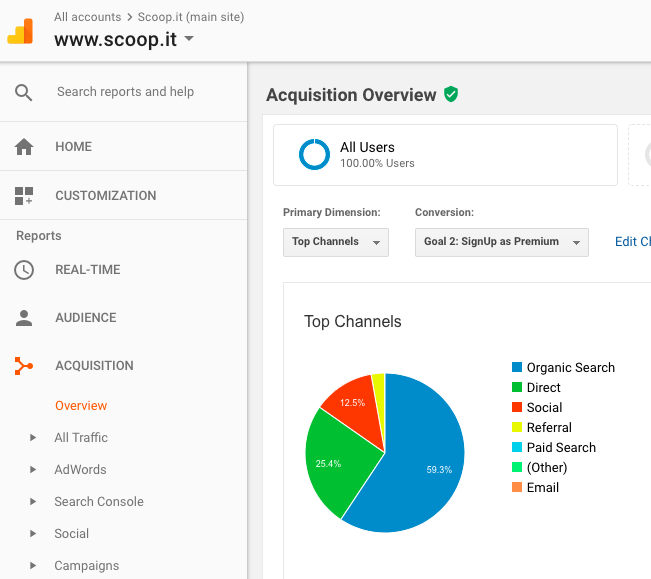We regularly have questions about the benefits of content curation for SEO. Does content curation help SEO? Isn’t it harmful duplicate content? Isn’t it low-quality content? How can I use it to get my original content to rank? And many more…
At Scoop.it, we’ve been observing the impact of content curation on SEO for a while so we wanted to summarize our findings and the recommendations we can derive.
Does content curation work for SEO? Some data
As mentioned, we have ourselves a lot of data points on this topic. Since 2011, we look at:
- Data from the Scoop.it platform itself, probably one of the largest traffic audience based exclusively on content curation, and where curated stories published by our users attract millions of visitors every month, 55%+ of which from Google Search.
- Data from our Scoop.it Content Director clients – a lot of which using a mix of curated and original content either in the form of curated blog posts or as curated content hubs.
We also curate and read a lot on this topic to analyze what other marketers observe and report, including:
- “Curating content delivers quality traffic, generates lots of backlinks, enhances your online presence and, therefore, boosts your SEO” (Cognitive SEO)
- “Content curation has the ability to bring content alive and generate traffic making it highly linkable” (Cognitive SEO)
- Content curation works as long as it’s accompanied by enough original content. (Search Engine Journal)
- “By running a solid campaign that allows you to publish curated content regularly, you can drive more referral traffic and get noticed by influencers in your industry. Ultimately, these conditions will increase your businesses’ reputation and rankings.” (Rankpay)
Why content curation helps SEO
Of course, we’re not Google and we can not say “Google works like this”. But we’ve made the following observations that lead to a methodology to use content curation for SEO.
- Content curation helps provide fresh content to a site: providing you have the right content curation tools, it’s much faster and easier to create a post with a few comments on third-party content than writing your own well-researched post (our research suggests 4-8x times faster). So in the same amount of time devoted to content production, you’ll publish more fresh content if you use a mix of curation and creation than if you rely solely on creation. This content freshness is a ranking factor: no site ranks for long these days without daily/weekly updates…
- The more content you publish, the more ranking opportunities you have. For the same reasons, you’ll have more content and each of these content pieces is a chance to rank – probably not for a highly demanded short-tail keyword but possibly for a long-tail keyword or keyword combination.
- Perhaps most importantly, curated content provides internal backlink opportunities to your original cornerstone content (the pieces that compete for the short tail keywords). Every time you add a comment to an article or a video you turn into a curated blog post, you can link to your own original piece on a related topic. You can naturally create internal backlinks that will signal your important content on your site and build an SEO cluster around it much faster with a combination of supporting keyword combination.
The last point is important to understand. As many SEO experts have explained, a modern approach to creating content that ranks consists in building clusters where your main content asset (also called a cornerstone piece) will be supported by a collection of satellite content on related topics that link back to it. As this HubSpot shows in the following diagram, topic clusters are the way to rank as Google moved from keywords to topics:
So while you should definitely focus on creating your pillar content, the question is: can you afford to create enough cluster content yourself to support your pillar content assets?
Content curation done right is your opportunity to do that without exponentially increasing your content budget.
Our recommended methodology to use content curation for SEO
So here’s our take on why and how to use content curation for SEO:
1. Content curation does not replace original content:
It’s a great way to support it but we absolutely recommend that you keep doing original content.
2. Evaluate the amount of supporting content you’ll need for each SEO cluster:
Creating a cluster of content can take dozens of related pieces of content. Don’t underestimate the workload.
3. Focus your content creation efforts on what matters (= pillar content):
Creating content is hard. Creating a lot of supporting original content is impossible. Our recommendation is to focus your original content creation work on cornerstone content that has a chance to rank for your strategic keywords.
4. Leverage curated content for your cluster content:
It’s to reach volume targets, maintain a strong update frequency and provide support to these cornerstone pieces through internal backlinks that we recommend using curated blog posts.
5. Format your curated blog posts according to best practices:
At the minimum, make sure your curated blog posts:
- include only a short quote from the original source (never the full article as it would be duplicate content while a short quote won’t),
- include a do-follow backlink to the original source (which, if the source is reputable, is a positive SEO signal),
- include your 150-300 word commentary (that our clients typically produce in 10-20’ so 4-8x faster than an original blog post)
- include an internal backlink to a piece of original cornerstone content.
6. Each of these curated blog posts will provide you with:
- an opportunity to rank on long-tail keywords / keyword combinations (it won’t beat original content but it still provides non-negligible traffic),
- more importantly, a wide range of natural internal backlinks to your original cornerstone content (therefore a way to build your SEO topic clusters more rapidly / build more topic clusters),
- a cost-effective way to maintain the freshness of your site, also a key ranking factor (no site ranks for long these days without daily/weekly updates…)
- an opportunity to reach out to curated sources and ask them for a backlink (it’s much easier to get a backlink when you’ve done the first step).
Note that we’re not saying this is the only way to use content curation for SEO.
- Another way to do it is to create a curated content hub, where you can display highly-valuable, engaging pieces of content.
- You could also curate by writing round-up posts, like this one for instance). However, keep in mind that although this type of post is an easy way to curate content, the process of gathering enough insights from contributors can be time-consuming!
Conclusion
If you want to boost SEO rankings, content curation is your best bet. Content curation helps you publish faster, and the more content you publish, the more ranking opportunities you have. However, you can’t expect proper results if you don’t make sure to follow content curation best practices and methodologies. We gathered them in a short eBook, don’t hesitate to check it out!






 (4 votes, average: 4.75 out of 5)
(4 votes, average: 4.75 out of 5)